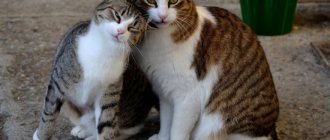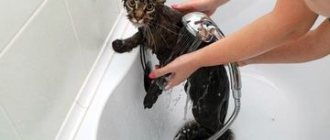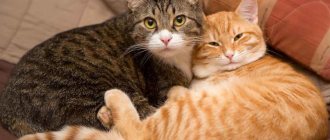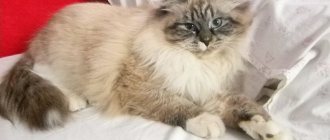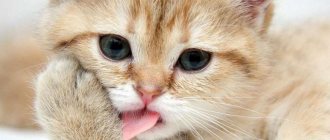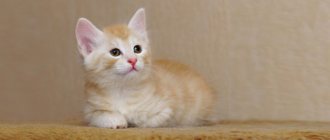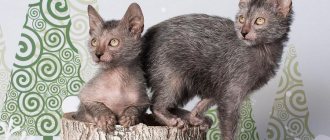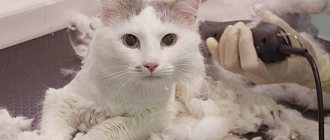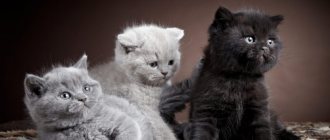History of the origin of the Siberian cat
The exact date when these cats appeared in Siberia is unknown. The first mention of cats that looked similar to modern Siberians and were called Bukhara cats dates back to the 16th century. Presumably they arrived with Russian settlers from trade trips to Asian countries, and quickly spread throughout the Russian Empire. At that time, long-haired beauties were valued primarily as excellent rodent hunters.
The breed was formed in the Urals and east of the Urals. Also, it is very common in the north of the European part of Russia, in the central and western regions of the country.
Another version of the origin of the Siberian breed suggests that Siberians are an aboriginal cat descended from wild cats, perhaps even from manul cats. But felinologists consider this version unconfirmed.
Disputes about who is the ancestor of Siberian cats are still ongoing. This breed is very similar to the Norwegian Forest Cat, but there are no related connections between them. Simply similar living conditions and climate endowed both breeds with thick hair, love of freedom and hunting habits.
Norwegian Forest Cat
Siberian cat
Feeding
The kitten's diet should include a variety of foods: soups, cereals, potatoes, dairy products. Dry food has been created specifically for small furry animals. When artificial feeding, there should be clean water in the bowl.
The weight of a kitten at birth is 70-120 g and rapid weight gain occurs, so nutritional intake is monitored monthly. Food should not only be varied, but also balanced according to BJU. Since Siberian cats are initially predators, proteins predominate in their food.
Note: There is no need to use cheap food to feed your baby. They can cause stomach pain, hair loss, and disruption of digestion processes. If you want to raise a healthy Siberian cat, then you need to feed him accordingly.
A Siberian cat at two years old is a beautiful, powerful and fully formed animal. If it has an unusual color and rich eye color, then it is a unique specimen. The price of the breed is related to the color of the coat and the origin of the kitten. If the parents are titled persons, then the price for their offspring is quite high. On average, a kitten costs from 5 to 25 thousand rubles. But you don’t mind spending any money on a handsome, fluffy dog with an easy-going character and hunting habits.
Description of the breed
Standard
Description of the appearance and character of the breed, according to the MAO, as well as signs of defects.
| Body |
|
| Head |
|
| Wool |
|
| Color |
|
Disadvantages of the breed / marriage
According to the standard, the following traits are not allowed in representatives of the Siberian breed:
- Body : elongated, overly slender body with light bones. Thin legs with small paws. Long neck. Tail that is short or longer than the body and has insufficient hair.
- Head : narrow muzzle with thin cheeks; flat profile, like Persian cats. Small eyes. Ears too big or small.
- Coat : lack of undercoat and tufts of hair between the toes. Cover coat lacking shine.
Health and illness
The Siberian cat has excellent health, although there cannot be 100% insurance against diseases. If not properly cared for, your pet may get sick:
- allergies (food or pollen);
- pathologies of the digestive tract (due to poor nutrition);
- disorders of the heart and vascular system, accompanied by coughing and difficulty breathing (the problem occurs with insufficient physical activity, as well as in older cats);
- urolithiasis (if left untreated, it can lead to kidney failure);
- periodontal disease;
- hyperactivity (mental pathology occurs when a cat is alone for a long time with low physical activity).
Important! White Siberian cats have a predisposition to cancer pathologies.
A veterinarian deals with the treatment of vascular diseases and urolithiasis in cats. In case of indigestion and food allergies, a change in diet is required.
In the digestive tract of a long-haired cat, lumps often form from ingested hairs. They come out on their own with vomit. But you can speed up this process by giving the cat a large spoonful of sunflower oil and the kitten a teaspoon.
Photos of Siberian cat colors
Black
Ginger
Blue
Cream
Color point
Seal Point
Red point
Blue Point
Tortoiseshell
Tortoiseshell with white
Smoky
Silver
Marbled Tabby
brindle tabby
Spotted Tabby
Gold
Character of Siberians
They are affectionate, but reserved, towards people. The Siberian cat will not ask to be held, but at the same time they will not leave the owner when he is ill. This breed is suitable for those who work a lot or are away from the apartment for a significant part of the day.
Attachment to the owner and family gets along with a proud and independent character. Quiet and unobtrusive cats, however, will not refuse to play with a family member. A pet can use anything that seems interesting to him as a toy.
Important! Siberians are proud and cannot tolerate sudden affection from their owners.
They love to watch what is happening from above, so you should not be surprised if you find this representative of the feline on cabinets, refrigerators, bookshelves and even on a chandelier.
The Siberian cat is an excellent hunter; it is capable of catching not only a mouse, but also a rabbit and a rat. Rest assured that a private house and its territory will be under reliable protection. She will happily bring a hunting trophy to her owner, which even reminds her of a dog.
These cats are brave protectors. They will protect the place that they consider theirs, keeping strange animals and people away. And they will definitely inform the owners about them. Siberians are not afraid of dogs or strangers, but they remain wary around them until they are sure of their safety.
Habits and character of Siamese cats
For breeding purposes, cats were once taken from harsh natural conditions, and this affects the character and habits of many generations of cats. This is an active and courageous hunter who will become a threat to all rodents in the house and in the area, and even the neighbor’s rabbits. The pet will enthusiastically bring both prey and some other thing in its teeth.
global $ads_google; //data-ad-slot=”2475549904″ $ads_google = empty($ads_google) ? false : true; ?> if ($ads_google == false) {?> $ads_google = true; ?> } ?>
Judging by the reviews of satisfied owners, the Siberian cat is fearless and loves to defend its territory from uninvited guests in the form of strangers and strange animals. They also have no fear of dogs. The family pet will not be scared by sharp sounds. You can be calm, the cat will not get into trouble without a good reason - the nature of the animal requires you to first check whether everything is safe.
The intelligence of the breed allows you to begin not only raising, but also training your pet in early childhood. There will be no problems with obedience and toilet training.
Raising this furry animal is a real pleasure. They are not picky and willingly play games with any item offered. Families with children like these characteristics.
The description of the character of the four-legged roommate also includes the words “discreet, affectionate, attentive.” Friendship with an animal is possible only if there is mutual respect for each other’s personal space, so if your pet has climbed high up to the ceiling, let him sit there as long as his feline heart desires.
Possible problems
Although the wool of the Siberian breed is considered hypoallergenic, this does not exclude the risk of developing allergies in family members prone to it. So, if in doubt, you should visit a doctor and do a test for yourself and those who live with you.
The second point is the required time to care for long hair. If you are not ready to brush your cat 1-2 times a week, and during the shedding period every other day or every day, then it is better to take a closer look at short-haired or hairless breeds. And yes, there will be wool everywhere and always, just like from any long-haired breed.
Hygiene
Cats that do not leave the house should be bathed no more than once a year. An animal that is taken for a walk should be bathed once a quarter. Cotton swabs are placed in the ears to prevent water from entering. Place a non-slip mat or towel on the bottom of the container. Shampoo-conditioners that are used for long-haired cats are used for washing. After bathing, dry the wool with a towel or hair dryer.
The pet's eyes should be wiped with cotton swabs or a clean napkin when discharge occurs. The ears are examined regularly. If you need to clean from wax and dirt, you need cotton swabs moistened with a special lotion. To cleanse teeth and mouth from plaque, toothpastes are used. It is periodically required to use preventative treats. Almost no nail trimming is required, so a standard scratching post is needed. Thanks to high-quality hygiene, the animal will always be happy.
How to choose a Siberian kitten
First of all, you should understand why you want to get a kitten of this breed. If you need a good companion or hunter, you should take a kitten whose parents do not have high titles. This way you won’t overpay for status.
But it’s better not to take a kitten without a confirmed pedigree and from your own hands. After all, then no one can guarantee you the purity of the breed and the absence of genetic defects. Do not forget that the character of the animal directly depends on the breed.
If you want to participate in exhibitions or in breeding, then you need to take a kitten with a good pedigree and a clearly defined breed exterior.
The price of a pet-class kitten (not for breeding) starts from 5,000 rubles , the cost of a breed and show class pet is higher and depends on the nursery. Color significantly affects how much a Siberian cat kitten costs. Gold, chinchilla and silver colors are valued above others.
Attention! Do not purchase animals from the poultry market.
Kittens for sale must be at least 3.5 months old , when they have already been weaned from their mother and vaccinated.
In addition to pedigree, pay attention to external qualities:
- A healthy kitten is cheerful and cheerful.
- The coat is shiny, and the eyes are clean and shiny.
- Ears, nose and anus are clean.
- The best option would be if not only you liked the kitten, but he liked you too.
Photos of Siberian kittens
Care
Siberians do not require serious personal care, but they cannot do without it at all. It is enough to comb your pet once a week. In spring and autumn, during molting, combing is done daily.
Feeding these felines is easy. They prefer natural and varied foods. There is only one need that is important to consider - the amount of protein during the growth of the animal.
It is better to take a wide tray with high sides. As a filler, you should choose large and heavy granules that will not cling to long hair.
Let's talk about everything in more detail.
Wool
You need to gradually train your cat to brush and, over time, she will expect the procedure herself. You should comb it before feeding so that the food serves as a reinforcer of positive emotions. Required equipment: wide and flat brush, double-sided for universal use, wide-toothed comb. You need to start combing with a sparse comb, then move on to a frequent comb, and finish with a brush.
Siberians are combed in the direction of hair growth. When the procedure ends, you need to lightly lift it with a brush, brushing it several times against the hair growth.
You should not bathe your cat more than 1-2 times a year. The only exception is if the cat is walking outside, then you need to wash its paws after each walk. The fur between the toes can be trimmed as it grows. This will make it easier for the cat to keep its paws clean, especially if it uses a litter box without litter.
It is recommended to include malt paste in the diet of long-haired breeds. It will help remove hairballs (trichobezoars) from the intestines, which are formed when a cat licks its luxurious fur coat.
Nutrition
The food bowl must be resistant to tipping over, not too deep and wide in diameter so that the whiskers do not touch the edges. The best materials to choose are glass, ceramics and stainless steel.
You need to choose and accustom your pet to a specific feeding place. After eating, it is recommended to throw away any leftover food and wash the bowls. Wash the bowl of water daily.
Portion sizes and food choices depend on the age and condition of the cat. No food allergic reactions have been identified in the breed, but personal intolerance to grains, lactose and poultry protein is possible.
Reference! A light-colored Siberian cat should not be given a lot of liver, as it causes darkening of the coat.
Ears, eyes and claws
Since cats of this breed do not suffer from excessive tearing, the eyes should be wiped with a damp, lint-free cloth as discharge occurs.
Ears need to be cleaned of dirt and wax about once a month.
These pets' teeth can be brushed once a week using a special toothbrush and toothpaste for cats. We wrote everything about the teeth cleaning procedure in this article.
Siberian cats' claws are rarely trimmed. The procedure for trimming nails is not difficult, especially if you train your pet from a young age.
Walk
The strong hunting instinct and habit of movement in cats make walking an essential part of the life of Siberians. Before going outside, you must wear a flea collar and harness. At first, you can walk with the kitten within the local area, gradually increasing the walking area.
Important! Siberian cats are not afraid of the cold, so they can walk for a short time even in winter.
Owner reviews
The maintenance and care of a Siberian cat has some peculiarities, since the animal loves street walks, regardless of the time of year. Cats of this breed can easily learn to use the litter box, but only as a last resort, since they prefer to relieve themselves outside, during walks.
You need to know this! Most owners note that it is better to feed a Siberian cat with natural food, regardless of age. Meat, fish, eggs, as well as plant-based ingredients in combination with vitamins and minerals are suitable for this.
The Siberian cat breed is characterized by high mobility and playfulness. Therefore, it is very important to ensure that the animal does not get bored. During games, a cat can damage furniture, household items and household items. In this regard, you should give the cat maximum attention, especially when the cat openly insists on being played with.
Breed card
| Characteristics of a cat | Notes | |
| General information | Historical breed. Large, long-haired cats that became popular in the late 80s | Until recently, Siberians were almost unknown outside of Russia. The characteristic color-point color even served as the basis for distinguishing the Neva Masquerade cat from the Siberian breed |
| Character | Curious, affectionate, but unobtrusive cats. Sometimes they can be willful, but they are very devoted to their owner and family. | Good with dogs |
| Appearance | Medium and large cats weighing up to 12 kg. Males are larger than females. Long hair, bushy tail and tufts of fur between the toes. Many colors | Cats look bulkier in winter when their fur becomes longer and thicker. |
| Behavior at home | An active cat breed that jumps well. They like to climb higher and watch what is happening from there. Beautiful hunters | Need a walk |
| Care | The fur does not mat, so it is enough to brush the cat once a week. | During shedding, your pet needs to be brushed daily. |
| Health problems | Golden Siberian cats sometimes suffer from hypertrophic cardiomyopathy | No genetic predispositions to diseases have been identified |
Video
* We invite you to watch a video about the Siberian cat . In fact, in front of you is a playlist in which you can select and watch any of 20 videos about a given cat breed by simply clicking on the button in the upper right corner of the window. In addition, the material contains quite a lot of photos. By looking at them you can find out what a Siberian cat looks like.
Rate the material!
[Total votes: 9 Average: 4.6]
The Siberian cat can be of almost any shade. These animals have a lively and inquisitive character, well adapted to cold areas. In addition, they are endowed with a heightened hunter’s instinct, which makes them especially useful for private homes: they will discourage rodents from settling even close to the house.
Breeding
Mandatory procedures:
- Rule out the presence of feline leukemia virus and immunodeficiency virus, and other viral and infectious diseases in pets.
- No more than 1 year and no less than 1 month before mating, vaccinate your pet against rabies, calicivirus, panleukopenia, rhinotracheitis, and chlamydia.
- Treat for worms in advance (2-3 weeks in advance).
- Trim nails the day before mating.
- Know exactly where and how to place the kittens.
You should choose a suitable cat in advance. If you are a beginner, then contact experts who will evaluate the female and also point out the advantages and disadvantages. You can look after the cat at the exhibition, where you can pick up a catalog with its participants. Having found a suitable one, it is worth taking care of a spare one, in case it does not merge with the main one.
Before going to the mating, you need to take a bowl, a carrier and your cat’s favorite bed, and stock up on treats. The meeting is traditionally held on the groom's premises.
At the place, be sure to make sure that it is clean and warm, after which, leave and leave the couple alone. The next day you should call and find out how everything went. If the mating is successful, the cat should be picked up after 1.5 days. Signs of pregnancy are visible after 30-35 days.
Typically, this breed produces 4 to 8 kittens per litter.
Catteries where Siberian cats are bred:
- “Russian Diamond”, Moscow.
- “Manchuri”, Voronezh.
- “From the Odyssey”, Moscow and Moscow region.
- “Property of Siberia”, Krasnoyarsk.
- “Moon haze” – Moscow, Moscow region, Yaroslavl.
- “Tale of Siberia” – Moscow.
- “Forest Tale” – Republic of Belarus, Minsk.
Estrus and mating
Siberian cats have a stable psyche, they are unhurried. Therefore, it is difficult to determine the exact period of pregnancy. Signs of this condition include drowsiness and toxicosis. During pregnancy, the cat's nipples enlarge for about a month, and then the belly becomes rounded.
You should not count kittens inside the womb by feeling the belly. This can injure the cubs. It is advisable to perform an ultrasound. A few days before giving birth, the cat looks for a birthing place. She fusses, looking for something warm.
It is advisable to put a box with a blanket. Childbirth occurs on days 64-72 of pregnancy. Breeders can accurately tell the due date of kittens. If you want to buy a healthy cat, it is advisable to contact a specialist. Siberian cats are excellent parents and usually do not require help from people.
